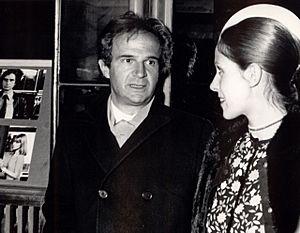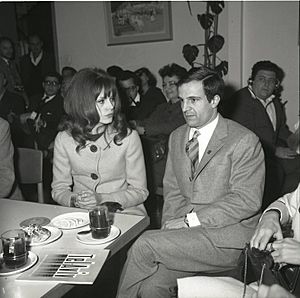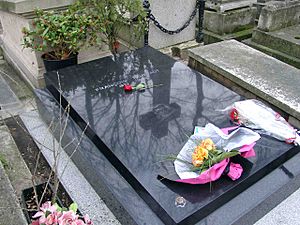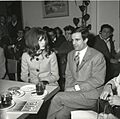François Truffaut facts for kids
Quick facts for kids
François Truffaut
|
|
|---|---|

Truffaut in 1965
|
|
| Born |
François Roland Truffaut
6 February 1932 Paris, France
|
| Died | 21 October 1984 (aged 52) Neuilly-sur-Seine, France
|
| Resting place | Montmartre Cemetery |
| Occupation |
|
| Years active | 1955–1984 |
| Movement | French New Wave |
| Spouse(s) |
Madeleine Morgenstern
(m. 1957; div. 1965) |
| Partner(s) | Fanny Ardant (1981–1984; his death) |
| Children | 3 |
| Relatives | Ignace Morgenstern (father-in-law) |
François Roland Truffaut (born February 6, 1932 – died October 21, 1984) was a famous French film director, writer, producer, actor, and film critic. Many people see him as one of the main people who started the French New Wave film movement. He worked in movies for over 25 years. He is still a very important figure in French film.
Truffaut's film The 400 Blows (1959) is a key movie of the French New Wave. It tells the story of a character named Antoine Doinel. This film had four follow-up movies: Antoine et Colette (1962), Stolen Kisses (1968), Bed and Board (1970), and Love on the Run (1979). Truffaut's 1973 film Day for Night won him many awards. These included the BAFTA Award for Best Film and the Academy Award for Best Foreign Language Film.
Other well-known films by Truffaut include Shoot the Piano Player (1960) and Jules and Jim (1962). He also made The Soft Skin (1964), The Wild Child (1970), and Two English Girls (1971). Later films were The Last Metro (1980) and The Woman Next Door (1981). Truffaut also acted in Steven Spielberg's science fiction movie Close Encounters of the Third Kind (1977). He wrote an important book called Hitchcock/Truffaut (1966). This book shared his interviews with director Alfred Hitchcock.
Contents
Growing Up in Paris
François Truffaut was born in Paris, France, on February 6, 1932. His mother was Janine de Montferrand. Her future husband, Roland Truffaut, adopted François. He gave François his last name. François lived with different nannies and his grandmother for several years. His grandmother taught him to love books and music. He lived with her until she passed away when he was eight. After her death, he moved in with his parents.
Truffaut often stayed with friends. He tried to be out of the house as much as possible. He knew Robert Lachenay from childhood. They were best friends for life. Lachenay inspired the character René Bigey in The 400 Blows. He also helped Truffaut on some of his films. Movies offered Truffaut a great escape from his home life. He was eight years old when he saw his first movie, Paradis Perdu (Paradise Lost, 1939). This started his love for films. He often skipped school and snuck into theaters because he did not have money for tickets. After being expelled from several schools, he decided to teach himself at age 14. He aimed to watch three movies a day and read three books a week.
Truffaut often visited Henri Langlois's Cinémathèque Française. There, he watched many foreign films. He learned about American directors like John Ford, Howard Hawks, and Nicholas Ray. He also studied the work of British director Alfred Hitchcock.
Starting a Film Career
Meeting André Bazin
In 1948, Truffaut started his own film club. There, he met André Bazin. Bazin greatly influenced Truffaut's life and career. Bazin was a film critic and led another film society. He became a close friend to Truffaut. He helped Truffaut with money and other problems when Truffaut was young.
Truffaut joined the French Army in 1950 when he was 18. He spent two years trying to leave the army. He was arrested for trying to desert and put in military prison. Bazin used his connections to get Truffaut released. He then helped Truffaut get a job at his new film magazine, Cahiers du cinéma.
Writing for Cahiers du Cinéma
For the next few years, Truffaut worked as a critic at Cahiers du cinéma. He later became an editor. He became known for his very harsh reviews. People called him "The Gravedigger of French Cinema." He was the only French critic not invited to the 1958 Cannes Film Festival. He supported Bazin in developing the auteur theory. This theory became very important in film studies.
In 1954, Truffaut wrote an article called "A Certain Trend of French Cinema." In it, he criticized French films. He said that many French screenwriters and producers were making bad movies. He listed eight directors he thought were not good at creating interesting characters or stories. These included Jean Renoir and Alfred Hitchcock. This article caused a lot of discussion. It led to Truffaut getting an offer to write for a bigger cultural magazine, Arts-Lettres-Spectacles. Truffaut wrote over 500 film articles for this magazine in four years.
Truffaut later developed the auteur theory more fully. This theory says that the director is the true "author" of a film. Great directors like Renoir or Hitchcock have unique styles and themes in all their movies. This idea was not widely accepted at first. But it gained support in the 1960s from American critic Andrew Sarris. In 1967, Truffaut published his book of interviews with Hitchcock, Hitchcock/Truffaut.
Making Short Films
After being a critic, Truffaut decided to make his own films. He started with a short film called Une Visite (1955). Then he made another short film, Les Mistons (1957).
Directing Feature Films
The 400 Blows
After seeing Orson Welles's Touch of Evil, Truffaut directed his first feature film. It was The 400 Blows (1959). This film was very popular and received great reviews. He won the Best Director award at the 1959 Cannes Film Festival. The movie follows a character named Antoine Doinel. It shows his difficult times in school, an unhappy home, and later, reform school. The film is very much like Truffaut's own life. Both Truffaut and Doinel were only children from unhappy homes. They both committed small crimes.
Truffaut chose Jean-Pierre Léaud to play Doinel. Léaud was a 14-year-old boy who auditioned for the part. He had a natural talent for acting on camera. Léaud and Truffaut worked together on many films over the years. Their most famous work was continuing Doinel's story in a series of films. These films are known as "The Antoine Doinel Cycle."
The 400 Blows marked the start of the French New Wave movement. This movement helped directors like Jean-Luc Godard and Claude Chabrol reach more people. The New Wave rejected traditional film structures. Truffaut had been writing about this idea for years.
Shoot the Piano Player
After The 400 Blows was successful, Truffaut made Shoot the Piano Player (1960). This film starred Charles Aznavour. It used unusual editing and voiceovers. Truffaut said that during filming, he realized he did not like gangsters. Since gangsters were a big part of the story, he made the characters more comical. This made the movie more enjoyable for him.
Critics liked Shoot the Piano Player, but it did not do well at the box office. The film focused on two elements popular in the French New Wave: American film noir and self-reflection. Truffaut did not experiment as much in his later films.
Jules and Jim and The Soft Skin
In 1962, Truffaut directed his third movie, Jules and Jim. It was a romantic drama starring Jeanne Moreau. This film was very popular and had a big impact on other filmmakers.
In 1963, Truffaut was asked to direct the American film Bonnie and Clyde. He was interested and helped develop the script. However, he decided not to direct it. Instead, Warren Beatty and director Arthur Penn made the film.
Truffaut's fourth movie was The Soft Skin (1964). It was not praised much when it first came out.
Fahrenheit 451
Truffaut's first non-French film was Fahrenheit 451 (1966). It was based on Ray Bradbury's science fiction novel. This film showed Truffaut's love for books. It was his only English-speaking film and was made in England. This was a big challenge for Truffaut because he spoke little English. It was also his first film in color. The large production was difficult for Truffaut, who was used to small crews and budgets. The film did not do well financially. Truffaut never worked outside France again. However, the film has gained a cult following over time.

Thrillers and Stolen Kisses
Stolen Kisses (1968) continued the Antoine Doinel series. It starred Claude Jade as Antoine's fiancée and later wife, Christine Darbon. This film was very successful around the world.
Truffaut worked on many different types of films. The Bride Wore Black (1968) was a revenge story. It was a stylish tribute to Alfred Hitchcock's films. Mississippi Mermaid (1969) was a romantic thriller. Both films were based on novels by Cornell Woolrich.
The Wild Child (1970) was the first film where Truffaut acted in a main role. He played an 18th-century doctor named Jean Marc Gaspard Itard.
Doinel's Story Continues
Bed and Board (1970) was another Antoine Doinel film. It also featured Claude Jade, now playing Léaud's on-screen wife.
Two English Girls (1971) was a love story similar to Jules and Jim. It was about a man who falls in love with two sisters. Such a Gorgeous Kid Like Me (1972) was a comedy that was not well received.
Day for Night
Day for Night won Truffaut an Oscar for Best Foreign Film. This film is often seen as his most thoughtful work. It tells the story of a film crew trying to finish a movie. They deal with many personal and work problems. Truffaut himself played the director of the fictional film being made. This movie included scenes from his earlier films. Many consider it one of his best works. Time magazine put it on its list of 100 Best Films of the Century.
In 1975, Truffaut gained more fame with The Story of Adèle H.. The main actress, Isabelle Adjani, was nominated for an Academy Award for Best Actress. His 1976 film Small Change was nominated for the Golden Globe Award for Best Foreign Language Film.
Later Films
The Man Who Loved Women (1977) was a romantic drama that was a small success. Truffaut also acted in Steven Spielberg's 1977 film Close Encounters of the Third Kind. He played the scientist Claude Lacombe.
The Green Room (1978) starred Truffaut in the main role. It did not do well at the box office. So, he made Love on the Run (1979). This film starred Léaud and Jade. It was the final movie in the Doinel Cycle.
The Last Metro
One of Truffaut's last films brought him international attention again. The Last Metro (1980) received 12 César Award nominations and won 10, including Best Director.
Final Works and Influence
Truffaut's very last film was shot in black and white. This gave his career a sense of coming full circle. Confidentially Yours was Truffaut's tribute to his favorite director, Hitchcock. It explored themes often found in Hitchcock's films, such as hidden guilt and a woman investigating a murder.
Truffaut loved to read and adapted many books into films. These included novels by Henri-Pierre Roché and Ray Bradbury's Fahrenheit 451. He also adapted Henry James's "The Altar of the Dead", which became The Green Room.
Many of Truffaut's other films came from his own original stories. He often wrote them with screenwriters like Suzanne Schiffman. These films covered many different topics. The Story of Adèle H. was a serious film inspired by the life of Victor Hugo's daughter. Day for Night showed the challenges of making a movie. The Last Metro was set during the German occupation of France during World War II. This film won ten César Awards.
Many filmmakers admire Truffaut's work. Tributes to his films have appeared in movies like Almost Famous and The Diving Bell and the Butterfly. Author Haruki Murakami also referenced him in his novel Kafka on the Shore. Film editor Walter Murch said Truffaut greatly influenced him when he was young. He was "electrified" by the freeze-frame ending of The 400 Blows.
Film critic Roger Ebert included The 400 Blows in his list of Great Movies. He also noted The Green Room (1978) as a curious and haunting film. This film is about people who love remembering their dead loved ones. Some critics believe The Green Room is Truffaut's best film.
Personal Life
Truffaut was married to Madeleine Morgenstern from 1957 to 1965. They had two daughters, Laura and Eva. Madeleine's father, Ignace Morgenstern, managed a large French film distribution company. He helped Truffaut get money for his first films.
In 1968, Truffaut was engaged to actress Claude Jade. She starred in his films Stolen Kisses, Bed and Board, and Love on the Run. Later, Truffaut lived with Fanny Ardant from 1981 to 1984. They had a daughter named Joséphine.
Death
In July 1983, Truffaut had his first stroke. He was diagnosed with a brain tumor. He passed away on October 21, 1984, at age 52. He died at the American Hospital of Paris in Neuilly-sur-Seine, France.
When he died, he was planning several new films. He had hoped to make 30 films and then retire to write books. He was five films short of his goal. He is buried in Montmartre Cemetery in Paris.
Images for kids
-
Truffaut and Claude Jade at the premiere of Love on the Run in Luxembourg, April 1979
See also
 In Spanish: François Truffaut para niños
In Spanish: François Truffaut para niños









